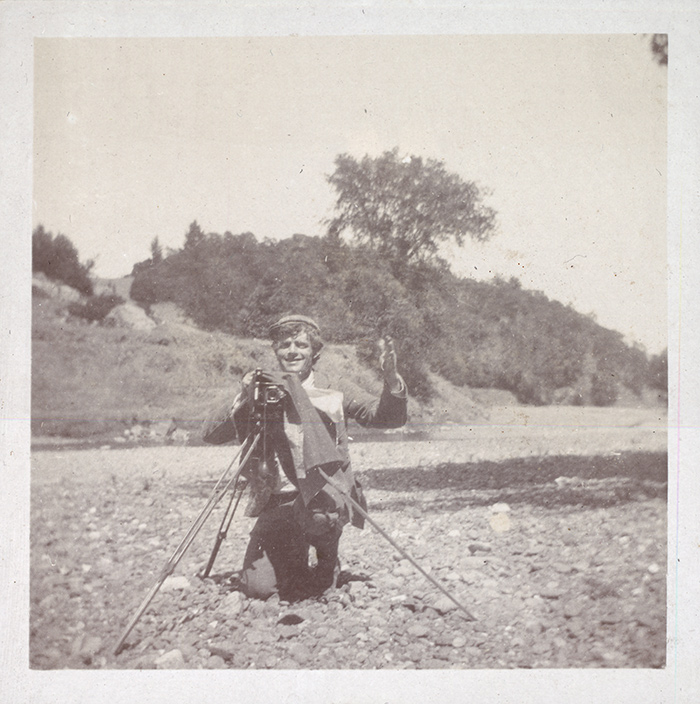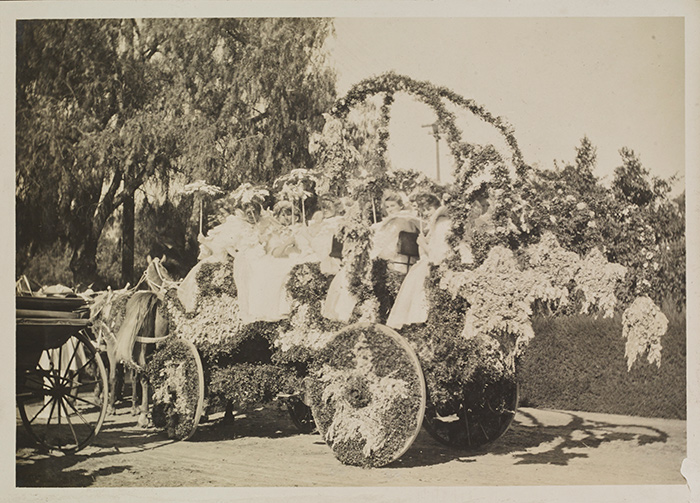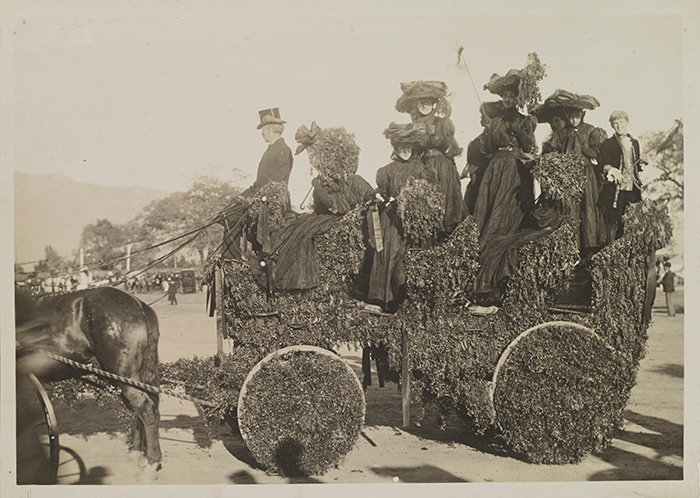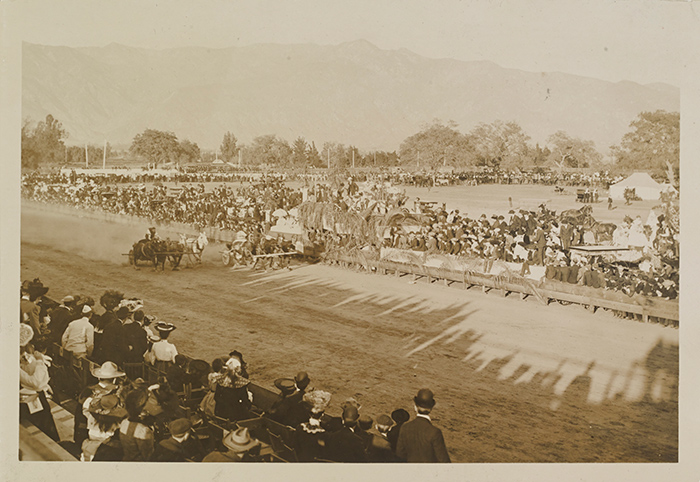Posted on Fri., Jan. 1, 2016 by
 Jack London kneels by his camera, ca. 1900. Jack London Collection. The Huntington Library, Art Collections, and Botanical Gardens.
Jack London kneels by his camera, ca. 1900. Jack London Collection. The Huntington Library, Art Collections, and Botanical Gardens.Watching the Rose Parade was a New Year’s tradition growing up. Granted, I usually saw it on television, even though I was just a few miles away from the parade route at my grandparents’ house in La Cañada. But I would visit the La Cañada-Flintridge float under construction before the parade, breathing in the heady aroma of thousands of flowers up close. And once, in college, I even spent the night in a sleeping bag on Colorado Boulevard, determined to take in the whole parade experience.
So I was delighted to come across some historic images of the Rose Parade while combing through The Huntington’s collection of Jack London papers, tucked within an album of photos from Korea and Japan. As assistant curator of literary manuscripts, I view fascinating bits of history every day. We hold the largest collection of Jack London materials in the world, including 12,000 photographs, and I am often searching for a particular image. But somehow I had never seen these pictures.
 Flowers were used to create stars that decorated the wheels of the float and the the rear of the trellised carriage, 1905. Jack London Collection. The Huntington Library, Art Collections, and Botanical Gardens.
Flowers were used to create stars that decorated the wheels of the float and the the rear of the trellised carriage, 1905. Jack London Collection. The Huntington Library, Art Collections, and Botanical Gardens.London is best known for his adventure stories, and for the true-life escapades that inspired those tales. London traveled to the Yukon during the Gold Rush, reported on the Russo-Japanese War from Korea, documented poverty in the East End of London, sailed the South Seas, visited Hawaii numerous times, traveled to Mexico, and lectured extensively in the Midwest and on the East Coast. He finally settled in Sonoma, spending considerable time in San Francisco and the Bay Area. But Pasadena? How was it that London found time between exotic locales to visit Pasadena, and what were the photographs doing in an album of photos taken in Korea and Japan?
With a little digging I learned that in the winter of 1904, after a journalistic jaunt to Korea, London came to Los Angeles to visit his friend and literary correspondent Cloudesley Johns. By then, Pasadena’s famous floral pageant was 15 years old and already a popular thing to attend on the first of the year, or Jan. 2, in London’s case. (An early and still-respected tradition holds that when Jan. 1 occurs on a Sunday, the Rose Parade takes place the following day.)
 A gentleman in a top hat drives a decorated carriage of ladies in dark dresses in what appears to be Tournament Park, at the end of the parade route, 1905. Jack London Collection. The Huntington Library, Art Collections, and Botanical Gardens.
A gentleman in a top hat drives a decorated carriage of ladies in dark dresses in what appears to be Tournament Park, at the end of the parade route, 1905. Jack London Collection. The Huntington Library, Art Collections, and Botanical Gardens.The exclusive Valley Hunt Club started the parade in 1890 to celebrate the warm weather and sing the praises of a community where roses bloomed while much of the country was blanketed in snow. More than 2,000 people attended the Rose Parade that first year. By 1895, the event had grown so large that the Tournament of Roses Association was formed to manage it. London’s photographs have no captions, but his images capture the whimsy and beauty of what was called “America’s New Year Celebration.”
London snapped 18 photographs, mostly of the floats themselves. These early floats were primarily flower-bedecked, horse-drawn carriages, though a few had more elaborate designs. London captured some of the riders in costume or carrying additional floral accoutrements. One float simulated a large boat with oarsmen to propel it down its waterless course. On another, flowers were used to create stars that decorated the wheels and the the rear of the trellised carriage.
 This large float simulated a boat, with oarsmen to propel it down its waterless course, 1905. Jack London Collection. The Huntington Library, Art Collections, and Botanical Gardens.
This large float simulated a boat, with oarsmen to propel it down its waterless course, 1905. Jack London Collection. The Huntington Library, Art Collections, and Botanical Gardens.London was an avid horseman, so it’s no wonder that he photographed the second annual chariot race, a form of post-parade entertainment introduced after the first Rose Bowl game in 1902. With a riotous crowd of 8,500 spectators packed into a space intended for 1,000, Michigan clobbered Stanford 49 to 0, and the game was called at the end of the third quarter with an unorthodox mercy rule. That convinced the organizers to try something new. Following the success of Lew Wallace’s wildly popular 1880 novel Ben-Hur, the organizers settled on chariot races, which took place from 1904 to 1915. London’s photographs reveal a large track and grandstands in Tournament Park, an area that now serves primarily as athletic fields for Caltech.
As for me, I’m still a big fan of the Rose Parade. When I married and moved to Pasadena, it seemed natural to join the Tournament of Roses Association and be a part of the magic. My husband was already a member, and I wasn’t going to spend New Year’s Eve alone while he had all the fun. The theme of this year’s parade—my tenth—is “Find Your Adventure.” During the parade, I’ll be thinking of Jack London and his many adventures, including the ones he experienced close to home.
 Chariot races were held from 1904 to 1915 in Tournament Park, an area now occupied by Caltech’s athletic fields, 1905. Jack London Collection. The Huntington Library, Art Collections, and Botanical Gardens.
Chariot races were held from 1904 to 1915 in Tournament Park, an area now occupied by Caltech’s athletic fields, 1905. Jack London Collection. The Huntington Library, Art Collections, and Botanical Gardens.Related content on Verso:
Jack London, Public Intellectual (Sept. 22, 2015)
To Build a Fire (Jan. 10, 2014)
The Star Rover (Jan. 12, 2012)
A Friend to Jack London (Sept. 15, 2011)
Natalie Russell is The Huntington’s assistant curator of literary manuscripts.